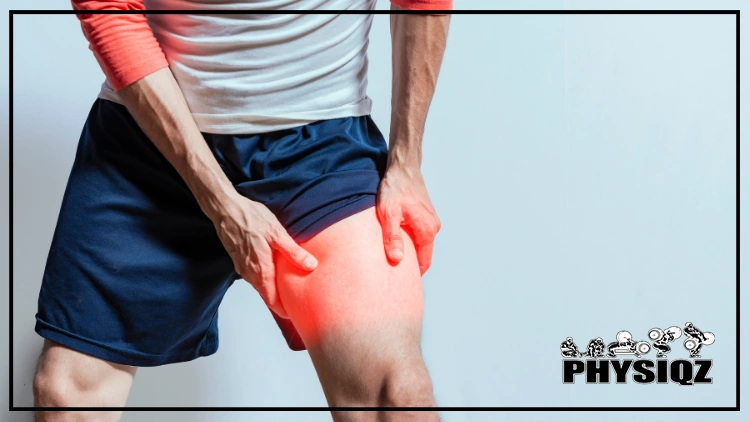
If your quads sore after squats, it could be due to various reasons such as lactic acid build-up, delayed onset muscle soreness (DOMS), potential muscle strain indicating an early injury, or incorrect form, possibly with the wrong squat variation.
Squats can be done in many ways and some variations actually emphasize the quads more, while others emphasize the glutes more so.
For example, high bar squats are more likely to make your quads sore than low bar squats. The same lies true for narrow stance vs wide stance squats, and heels raised vs flat feet squats.
Much of this is due to a change in lever arms and this image provides an illustrated example. With this in mind, we’ll review several variations that emphasize the quads, which ones take some load off of the quads.
Additionally, we’ll go over why lactic acid builds up, more specifics about DOMS, possible injuries that may arise, squat alternatives to squatting when you’re sore, remedies, and how to fix each one of these so you can squat without feeling like your quads are going to explode or fall off.
Why Are My Quads Sore After Squats? Why Are My Legs Sore After Squats?
The cause of sore quads after squats may be hard to pinpoint whether it is an injury or the typical type of soreness that can be expected from an intense workout. However, there are some common reasons that makes legs sore after squats and they include:
- Delayed onset muscle soreness (DOMS) which is the most common issue
- Fatigue as a result of moving heavy weight
- Improper form and technique
- Using a squat variation that recruits the quads heavily
- Lactic acid build up
- The quads are the primary movers and are therefore susceptible to soreness
Whatever the reason may be, it is imperative that lifters uphold good form and technique throughout the entire squat movement to properly engage and recruit all the muscles that should be involved. This ensures that each muscle group is doing its part and there is no over reliance on certain muscles over the others—for example, not engaging the glutes enough at the expense of the quads.
In this way, efficient back squats are executed bringing massive gains while preventing chronic soreness and injury in the long run.
Certain Squat Variation Emphasizes the Quads More Than Others
There are some squat variations that recruit the quads more than others, these include narrow stance squats and high bar squats:
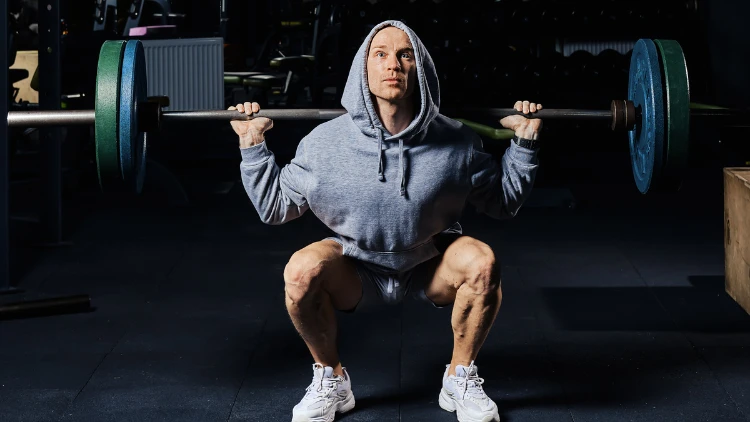
Source: Aleksei Isachenko via Canva.com1
- Narrow Stance Squats—These are performed with feet shoulder width apart or sometimes narrower, engaging the quads intensely, especially at the lower part of the movement.
- Bulgarian Split Squats—This is a unilateral movement that places the legs in a split position and highly engages the quads.
- High Bar Squats—The barbell is placed in a high position on the traps across the shoulders resulting in less stress on the back but heavily activating the quads which makes them so sore after squats.
- Front Squats—Front squats have the barbell resting on a shelf created by the clavicles and they zone in on the front of the body emphasizing the quads and upper back.
- SSB Squats—The SSB results in the barbell being in a high position which places extra strain on the quads and the mid/upper back.
- Pistol Squats—These use a single leg to squat deeply and rely intensely on the quads.
- Goblet Squats—Similarly to a front squat, a lifter holds the weight (dumbbell or kettlebell) to the chest emphasizing the quads.
How To Fix (The Solution): Oftentimes, sore quads are a result of weak quads. Rather than shying away from these quads intensive variations, lifters should include them into a regimen to build quad strength.
Improper Form or Technique
Lifters who are constantly experiencing soreness in the quads should pay attention to their squat technique—that is if they are mirroring the variations aforementioned; for example, a narrow stance and/or having a high bar placement.
These variations tend to recruit the quads more intensely than others.
Therefore, gym goers experiencing this issue should look to make some adjustments to their technique in several ways including a wider stance and altering the bar position.
- Widening the Stance—A wider stance will engage the glutes more particularly at the bottom phase of the squat which is a significant muscle group, being the largest and one of the most powerful muscles in the human body.2 This takes pressure off the quads so that they don’t bear the brunt of the load.
- Bar Position—In comparing a high bar versus low bar squat, the main distinction lies in the bar position. In the high bar squat, the barbell rests on the traps, promoting a more upright torso to centralize the weight, thereby intensifying engagement of the quads. By keeping the bar lower on the rear delts as in a low bar squat, it will require the lifter to lean forward to keep the weight centered—this adjustment will recruit the glutes more.3
How To Fix (The Solution): Either widen the stance to having the feet placed 1.5-2 times hip width with toes pointed slightly outward and/or lower barbell to the rear delts to recruit the glutes more to assist the quads.
Lactic Acid Build-Up
Lactic acid build up has long been blamed for muscle soreness after a workout—this known as DOMS to be delved into below; however, research has proved otherwise.4 Lactic acid (lactate) is produced as a byproduct by the body during high intensity workout which builds up in the muscle and eventually passes into the bloodstream.
This eventually leads to a lactic acid build up in the muscles since it is being produced faster than the body can break it down during long intense workouts. As a result of this build up, there will be a burning sensation which causes soreness in the quads during the workout.
When lactic acid builds up in the muscle, it also becomes a major cause of decline in muscle power as it causes a diminished CNS drive to muscle.5
How To Fix (The Solution): Lactic acid dissipates as soon as the session is over, as the lactic acid levels return to normal.
Delayed Onset Muscle Soreness (DOMS) Can Make Your Quads Sore Days After Squatting
DOMS in quads, unlike lactic acid build-up, is a form of soreness that arises after the workout, rather than during it. It occurs as a result of the lifter placing loads on the muscles (quads) which they are not accustomed to handling and typically develops 12-24 hours after exercising and produces the most intense pain 24-72 hours after squatting.
The cause of this soreness is attributed to the muscles repairing the micro tears that developed during the exercise. DOMS is the primary reason why your legs are so sore from squats that you can’t walk with ease. The unaccustomed loading is not necessarily confined to squatting heavier but could also due to:
- Increasing training volume (reps X weight X sets)
- Slowing the tempo of the reps thus increasing time under tension which is the time muscles spends contracting and stretching under a load
How To Fix (The Solution): DOMS will reduce in majority of the cases after the 24-72 hour window period elapses. Athletes, particularly those who train daily should therefore reduce intensity of exercise 1-2 days after an intense DOMS inducing leg workout.6
Using Too Much Weight or Intensity That Overuses, Strains or Injures the Muscles
As stated in the above section, symptoms of DOMS will set in once a lifter increases the weight beyond which their quads are accustomed to. This scenario may also arise from an elevated volume of training, particularly when introducing activities like a squat and deadlift routine on the same day, which the muscle may not be accustomed to.
Consequently, the quads endure excessive strain and overuse, leading to injuries that require repair, resulting in quads sore after squats.
It should be stated that this is the process that induces hypertrophy (muscle growth) as the body adapts to the stresses placed upon it, and be in a better position to handle the intensity the next time, by growing muscle mass and being stronger.7
How To Fix (The Solution): Gradually increase working out intensity rather than suddenly, to allow the quads to get steadily accustomed to the loads.
The Quads Are a Primary Mover in Squats
Squats are known as a quad-dominant and demanding exercise because the quads are the primary movers in the movement, supported by the hamstrings, core muscles, inner thigh muscles, calves, and glutes to complete the motion. At the deepest part of the squat, the quads are intensely involved in working to extend the knees out of the bottom.
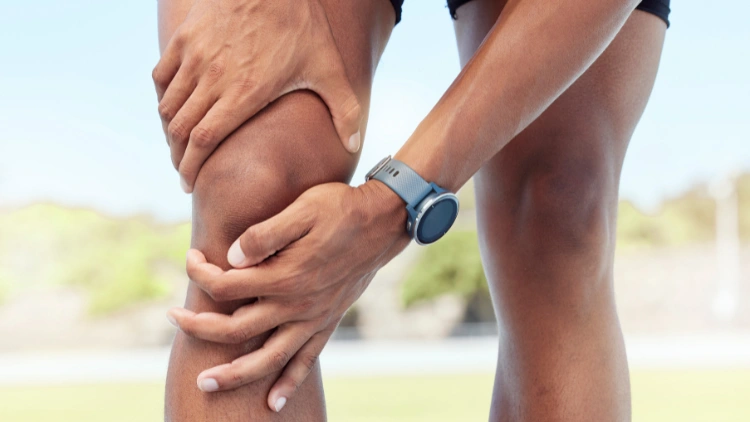
Source: Peopleimages.com – YuriArcurs via Canva.com8
Therefore, the deeper the squat, the more quad involvement. It follows that not going deep in the squats also reduces the reliance on the quads.
To reduce over reliance on the quads, changes to the stance and barbell position should bring in the glutes into play
How To Fix (The Solution): To increase glute activation, consider widening your stance and/or using a low bar position to reduce quad engagement and emphasize the glutes more, potentially leading to experiencing glute pain after squats. Avoid going too deep as this activates the quads more.
Which Muscles Should Be Sore After Squats?
Squats primarily engage the muscles of the lower body, with some involvement from the upper body. After completing squats, it’s typical for the quads, glutes, hamstrings, and adductors (inner thigh muscles) to feel sore, which often leads to thighs hurting after squats.
While the core muscles (upper body muscles) are involved in the movement, they generally are not sore.
Which Should Be More Sore After Squats: Quads vs Glutes?
After a squatting session, ideally both the quads and glutes should have the same levels of soreness. When the quads are excessively sore, it is a telltale sign that the squat mechanics are not up to par—barring the times when a lifters wants to specifically emphasize the quads more than the other major movers in the movement such as narrowing the stance or using a high bar squat that forces them remain an upright torso increasing quad engagement.
Tips & Remedies for Relieving Sore Quads After Squats (Ways to Alleviate Soreness in Legs from Squats)
Fortunately, there are several tips and fixes that can be followed to remedy sore quads after squatting, with the exception of the presence of injuries. These include stretching and foam rolling, warming up and cooling down techniques and maintaining proper nutrition and hydration levels.
Rest & Recovery
When symptoms of DOMS and/or quads fatigue set in, lifters should give the muscles time to recuperate and recover to regain strength. Typically 48-72 hours is sufficient time for the symptoms to abate and the legs can once again be worked out safely.
Active Recovery Exercises
After an intense workout that leaves quads hurt after squats, it’s tempting to recline and indulge in TV time, particularly when the simple act of squatting to sit feels like a monumental task. However, to get the most out of a fitness routine it is ideal to include active recovery exercises such as walking, biking and reverse lunges.
These will prevent injury and burnouts due to over training. These active recovery exercises can be included:
- Walking briskly
- Swimming
- Biking
- Using an elliptical and/or rowing machine
- Lateral band walk
- Reverse lunges
Stretching & Foam Rolling Can Prevent Sore Legs After Squats
Stretching and foam rolling are effective techniques at combating quad soreness after squatting; stretching helps the body rid itself of lactic acid and helps relax the muscles. The quad stretch can be done while standing or kneeling.
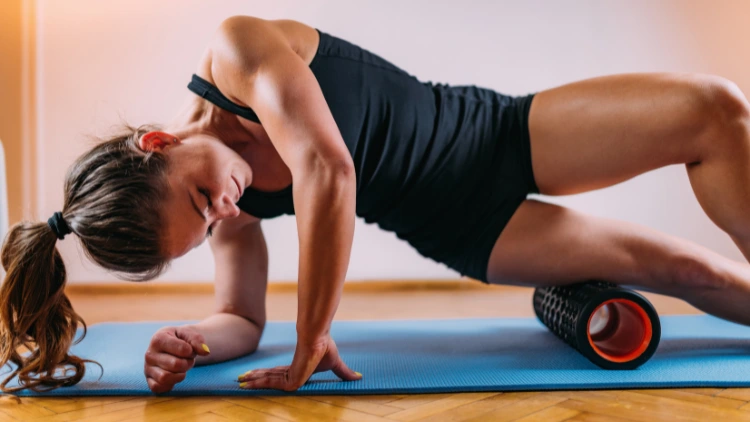
Source: microgen via Canva.com9
Foam rolling can be a painful experience but it is very valuable at helping repair muscles, can reduce swelling and catalyze tissue healing. Using a foam roller for 20 minutes on roller (high density) right after a workout and 24 hours can reduce muscle tenderness and the impact of DOMS.10
Proper Nutrition & Hydration
Proper nutrition and hydration are crucial to aid in post recovery efforts. Increasing protein intake from high quality sources such as white chicken breast and fish has been shown to help muscles recover from workouts that are dominated by eccentric contraction (muscle lengthens).
Antioxidants will also help in the recovery.11
Drinking plenty of water and staying hydrated will speed up recovery by helping by the body eradicate toxins and help the muscles remain in proper working order.12
Proper Warm-Up & Cool-Down Techniques
Engaging in both warm-up exercises prior to a back squat session and cooldown activities afterward can effectively alleviate and diminish the discomfort associated with sore thighs resulting from squats. A proper warm-up minimizes injury risks and is likely to decrease the symptoms of delayed onset muscle soreness (DOMS).
Riding on a stationary bike for a few minutes and warming up with an empty bar is ideal.
Cooling down allows the muscles to be ready for recovery better and a 2014 study concluded active recovery rather than passive recovery (resting completely) resulted in increased performance during strength training in the bench press.13
Exercises To Strengthen & Prevent Soreness in the Quads & Legs
While it may seem counterintuitive, lifters may need to train their quads more because they are likely to be weak, especially if they are only being trained once a week. Incorporating certain squat accessory exercises aimed at targeting the quads, such as lunges, leg extensions, and leg presses, may help alleviate symptoms of post-squat leg soreness.
There is an added benefit in training for a second time during the week as opposed to training once a week which will increase strength and muscle gains.14 They could alternatively be trained lightly during the week to ‘warm them up’ for the heavy squat sessions with the below exercises.
Squats With Proper Form & Technique
Squatting with proper form will go a long way in ensuring that the quads are not over relied upon and engaging other muscles such as the glutes and inner thighs. As explained earlier, squatting with bad form is typically a culprit for overly sore quads after squatting.
Ensure these cues for proper form and maintaining an efficient squat bar path are adhered to:
- Chest and shoulders back
- Sit back as if sitting on a chair
- Knees out and not buckled
- Accelerate out of the bottom
Lunges & Variations
Lunges are a powerful exercise that can be used to target the lower body particularly engaging the quads, hamstrings and glutes. The quads work with the hamstrings and glutes to control the descent and then forcefully contract to push the body back to the starting position.15
They are also effective because they work the primary movers in an eccentric phase, which is ideal for muscle size and strengthening.16 In addition to these benefits, they are a unilateral exercise which means they will address muscle imbalances. There a number of variations available including:
- Side lunges
- Stationary lunges
- Walking lunges
- Reverse lunges
- Twist lunges
- Curtsy lunge
Leg Press & Variations
Leg press machines often get a bad rapport in the fitness world as a tool that is dismissed and relegated to gym goers that don’t want to squat. Nothing could be further from the truth, as they are a viable way to isolate the quads and can be loaded heavy.
A 2018 study comparing the viability of the leg press vs the squat showed both exercises provided benefits for a lower body workout routine.17
There is no need for stabilizing the load, meaning the leg press allows the lifter to press heavy weight with control. It’s important to note that lifters can assess and calculate their lifting capacities for both leg presses and squats, and vice versa, using the leg press to squat conversion. This can be particularly helpful for understanding why some individuals can lift more weight on the leg press compared to squats.
Leg press variations include:
- One leg press
- Leg press with a resistance band
- Wall sit
- Smith machine squat
- Lower foot placement leg press
- Higher foot placement leg press
Leg Extension
Leg extensions are performed with a lever machine and do a great job at isolating the quads and have been used by elite bodybuilders to complement heavy squat work. They are great at strengthening and sculpting the rectus femoris and vastus muscles of the quads.
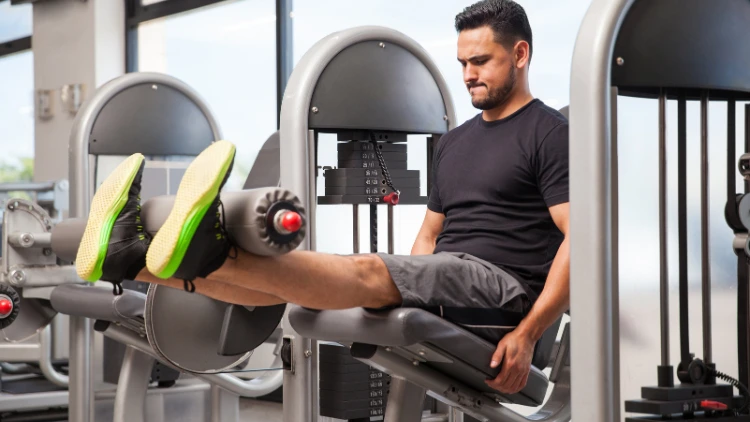
Source: Antonio_Diaz via Canva.com18
Leg extensions are an open chain kinetic exercise, unlike the squat which is a closed chain kinetic exercise.19
In a closed chain kinetic exercise like the squat, the feet are anchored to the ground while in the leg extension, the feet are moving the padded bar and the legs are not stationary. Leg extensions add volume to training regimen without fatiguing the lifter much compared to squats which makes them viable for getting stronger quads which will help prevent quads sore after squats.20
Leg Curls
While leg curls do target the hamstrings, these muscles are a critical component to ensuring that the quads are not overloaded. The quads are responsible for extending the knees, but the hamstrings work together with them and ensure the knee joint remains stable.
These machines will allow a lifter to strengthen their hamstrings without placing additional stress on their lower back.
It should be stated that squats do not train hamstrings very well making this exercise a valuable addition to ensure muscle balance between the front and back of the legs.
Should I Train Legs if They Are Still Sore?
Generally, it is not ideal to train legs sore after squats, especially if it is affecting the movement and causing other muscle groups to help the struggling quads. This is a sign that the muscles have not had sufficient time to recover and heal which could lead to an overuse injury.
However, if the ache is somewhat satisfying and mild and there is no compromise in form as a result, then there should not be negative outcomes from this workout.
Importance of Seeking Medical Attention if Soreness Persists
In the case where the quads have not given enough time to heal and are still being trained, or are simply taking longer than is typical to heal (48-72 hours), then this could be a sign of an injury such as an overuse injury or even worse, a fracture.
Often, minor strains will heal on their own and sometimes with assistance from RICE (rest, ice, compression and elevation):
- Rest—Proper rest and recovery time.
- Ice—Applying ice to help reduce pain and swelling but should only be done after 48 hours of when pain commences.
- Compression—Wrapping the affected area will reduce swelling but not too tight as to restrict blood flow.
- Elevation—Raising the legs above the level of the heart on a pillow can reduce pain.
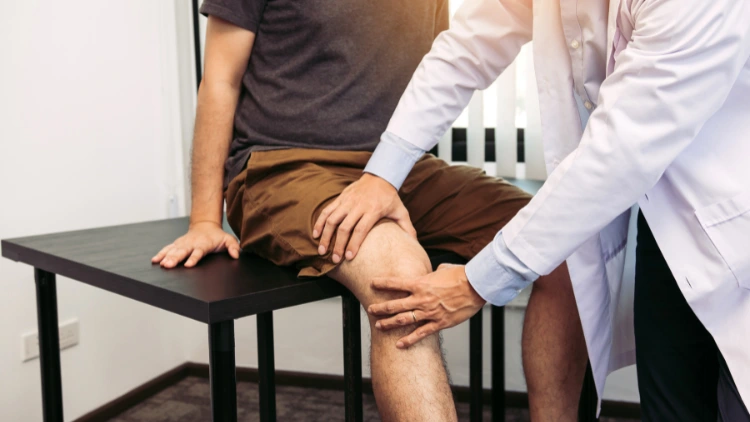
Source: wutzkoh via Canva.com
Over the counter anti-inflammatory medicine can be taken such as ibuprofen (Advil), or naproxen (Aleve) and acetaminophen (Tylenol) to ease pain and swelling.
If the pain persists even after taking these steps, then it is vital to consult medical treatment to identify the issue. If left untreated, this may lead to long term complications which will hamper future training sessions.
While having quads sore after squats may occasionally happen, it should not be a chronic issue that affects lifters as it may seriously impact the ability for lifters to extract the most from their training—there are number of fixes and remedies for this soreness including making adjustments to stance and including strategies such as stretching and warming up before a squat session.
Frequently Asked Questions
Should the Legs Be Hurting 2 Days After Doing Squats?
Typically, it takes 48-72 hours for the symptoms of DOMS to subside, which is often the primary reason behind experiencing soreness in the legs after squats.
Why Are the Quads Usually More Sore Than Other Muscles After a Squat?
The quads may be more sore than other muscles either because they are weak or they are being emphasized by the technique of squatting such as using a narrow stance and/or having the barbell placed high at the traps.
Do Squats Workouts the Glutes?
Certainly, the glutes are a significant muscle group engaged in the squat, responsible for hip extension as the lifter rises from the bottom position. Their activation is the main cause of soreness in the glutes following squats.
Can Squats Reduce Fat Around the Legs?
Squats do not specifically target the fat around the legs, but what they will do is help shape and tone the legs while also tightening the glute muscles.
References
1Isachenko, Aleksei. Canva. Accessed 18 May 2023. <https://www.canva.com/photos/MAEMKIIJGJ0-muscular-man-training-squats-with-barbell-in-gym/>
2Stian Larsen, E. K. (2021, September 1). Effects of Stance Width and Barbell Placement on Kinematics, Kinetics, and Myoelectric Activity in Back Squats. Retrieved 2023, from <https://www.ncbi.nlm.nih.gov/pmc/articles/PMC8440835/>
3Eirik Kristiansen, S. L. (2021, August 6). A Biomechanical Comparison of the Safety-Bar, High-Bar and Low-Bar Squat around the Sticking Region among Recreationally Resistance-Trained Men and Women. Retrieved 2023, from <https://www.ncbi.nlm.nih.gov/pmc/articles/PMC8392107/>
4Cong Zeng, G. L. (2022, January). The Application of DOMS Mechanism and Prevention in Physical Education and Training. Retrieved 2023, from <https://www.ncbi.nlm.nih.gov/pmc/articles/PMC8759844/>
5Cairns, S. P. (2006). Lactic acid and exercise performance : culprit or friend? Retrieved 2023, from <https://pubmed.ncbi.nlm.nih.gov/16573355/>
6Karoline Cheung, P. H. (2003). Delayed onset muscle soreness : treatment strategies and performance factors. Retrieved 2023, from <https://pubmed.ncbi.nlm.nih.gov/12617692/>
7Young sub Kwon, M. ,. (2004). How do muscles grow? Retrieved 2023, from <https://www.unm.edu/~lkravitz/Article%20folder/musclesgrowLK.html>
8Peopleimages.com – YuriArcurs. “Closeup of One Man Holding Sore Knee from Exercising Outdoors. U.” Canva. Accessed 26 April 2023. <https://www.canva.com/photos/MAFG0MAGnFY-closeup-of-one-man-holding-sore-knee-from-exercising-outdoors-u/>
9microgen. “Woman Massaging Legs with Foam Roller.” Canva. Accessed 26 April 2023. <https://www.canva.com/photos/MAD-VsTHrL0-woman-massaging-legs-with-foam-roller/>
10Eric M Scudamore, B. L. (2021, July). Effects of foam rolling for delayed onset muscle soreness on loaded military task performance and perceived recovery. Retrieved 2023, from <https://pubmed.ncbi.nlm.nih.gov/33786041/>
11Ives, S. (2017). Effects of a combined protein and antioxidant supplement on recovery of muscle function and soreness following eccentric exercise. Retrieved 2023, from <https://www.academia.edu/59807448/Effects_of_a_combined_protein_and_antioxidant_supplement_on_recovery_of_muscle_function_and_soreness_following_eccentric_exercise>
12Lawrence W. Judge, D. M.-N. (2021, July 28). Hydration to Maximize Performance and Recovery: Knowledge, Attitudes, and Behaviors Among Collegiate Track and Field Throwers. Retrieved 2023, from <https://www.ncbi.nlm.nih.gov/pmc/articles/PMC8336541/>
13Felipe A. S. Lopes, V. L. (2014, March). The Effect of Active Recovery on Power Performance During the Bench Press Exercise. Retrieved 2023, from <https://www.ncbi.nlm.nih.gov/pmc/articles/PMC4096096/>
14Eisuke Ochi, M. M. (2018, July 2). Higher Training Frequency Is Important for Gaining Muscular Strength Under Volume-Matched Training. Retrieved 2023, from <https://www.ncbi.nlm.nih.gov/pmc/articles/PMC6036131/>
15José M. Muyor, I. M.-F.-R.-V. (2020, April 1). Electromyographic activity in the gluteus medius, gluteus maximus, biceps femoris, vastus lateralis, vastus medialis and rectus femoris during the Monopodal Squat, Forward Lunge and Lateral Step-Up exercises. Retrieved 2023, from <https://www.ncbi.nlm.nih.gov/pmc/articles/PMC7112217/>
16Brad J Schoenfeld, D. I. (2017, September). Hypertrophic Effects of Concentric vs. Eccentric Muscle Actions: A Systematic Review and Meta-analysis. Retrieved 2023, from <https://pubmed.ncbi.nlm.nih.gov/28486337/>
17Fabrício E Rossi, B. J. (2018, March). Strength, body composition, and functional outcomes in the squat versus leg press exercises. Retrieved 2023, from <https://pubmed.ncbi.nlm.nih.gov/27735888/>
18Antonio_Diaz. Canva. Accessed 18 May 2023. <https://www.canva.com/photos/MADBmG9liKw-young-man-doing-leg-extensions/>
19Dawid Bączkowicz, K. K. (2019, Janurary 31). Analysis of patellofemoral arthrokinematic motion quality in open and closed kinetic chains using vibroarthrography. Retrieved 2023, from <https://pubmed.ncbi.nlm.nih.gov/30704430/>
20Antonio Paoli, P. G. (2017, December 22). Resistance Training with Single vs. Multi-joint Exercises at Equal Total Load Volume: Effects on Body Composition, Cardiorespiratory Fitness, and Muscle Strength. Retrieved 2023, from <https://www.ncbi.nlm.nih.gov/pmc/articles/PMC5744434/>